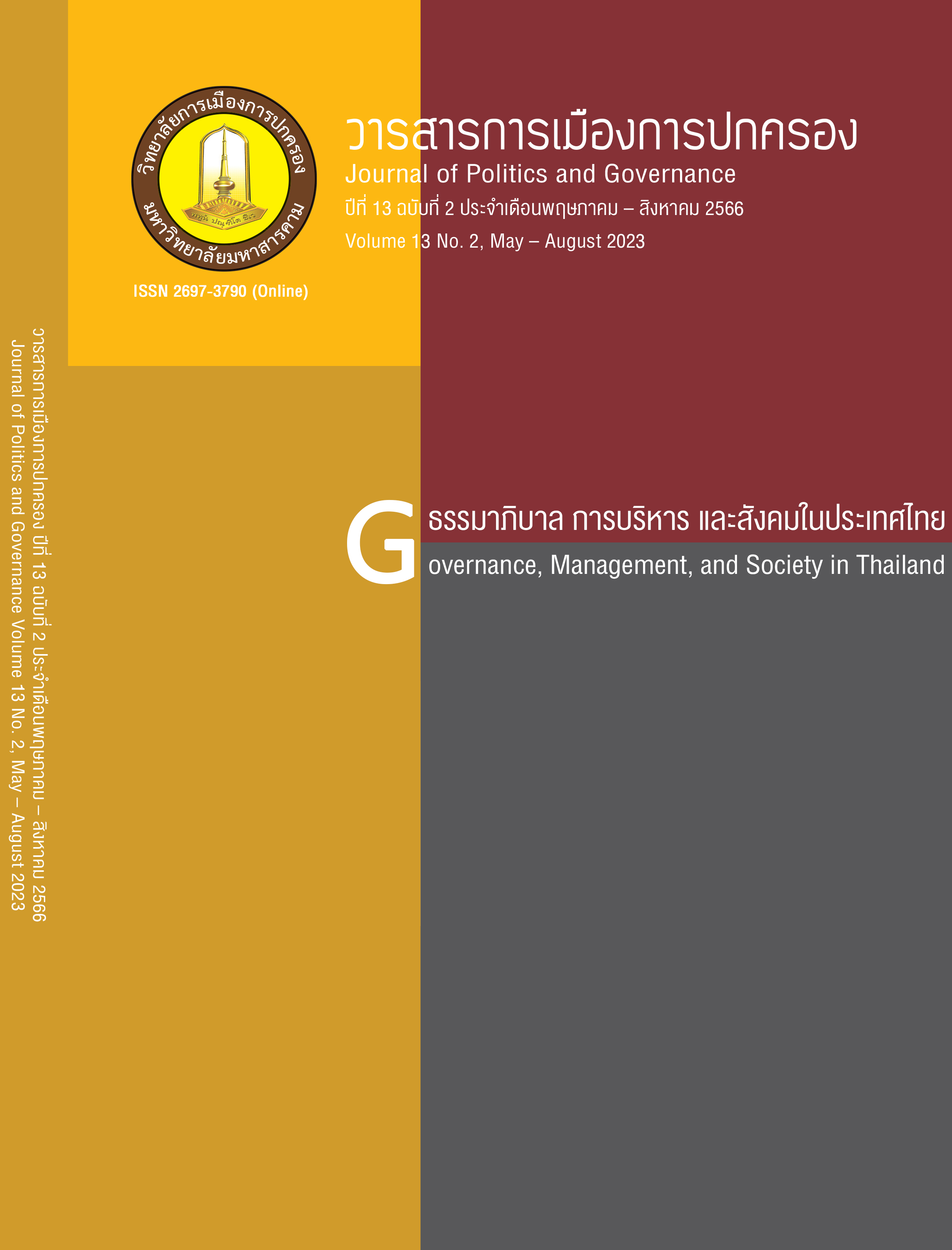บทบาทภาวะผู้นำในการจัดการภาวะวิกฤตในสถานการณ์การแพร่ระบาด ของเชื้อไวรัสโคโรนา 2019 ในประเทศไทย
Main Article Content
บทคัดย่อ
บทความนี้มีวัตถุประสงค์เพื่อศึกษาบทบาทภาวะผู้นำในการจัดการภาวะวิกฤตในสถานการณ์การแพร่ระบาดของเชื้อไวรัสโคโรนา 2019 (COVID-19) เนื่องจากเป็นบททดสอบความสามารถของผู้บริหารที่ต้องแสดงออกถึงภาวะผู้นำในการจัดการภาวะวิกฤตอย่างเร่งด่วน เพื่อลดผลกระทบที่จะเกิดขึ้นเป็นวงกว้าง และดำเนินการอย่างมีอย่างมีประสิทธิภาพ เพราะการแพร่ระบาดของโรคติดเชื้อไวรัส COVID-19 เป็นโรคอุบัติใหม่ที่ทั่วโลกต่างได้รับผลกระทบที่ยากต่อการควบคุม ซึ่งพบว่าบทบาทของผู้นำมีความสำคัญอย่างยิ่งต่อการจัดการการแก้ไขปัญหา โดยอาศัยการใช้ “ศาสตร์” และ “ศิลป์” ในการบริหารงาน ทั้งนี้ บทบาทภาวะผู้นำในการแก้ไขปัญหาของประเทศจะต้องมีภาวะความเป็นผู้นำที่สูง ซึ่งประกอบได้ด้วย มีแนวทางในการบริหารงาน มีระบบการทำงานที่มีประสิทธิผล การมอบอำนาจไปยังหน่วยงานที่เกี่ยวข้อง คำนึงถึงส่วนรวม การสร้างแรงบันดาลใจ การสื่อสารที่ชัดเจน การเรียนรู้อยู่เสมอ มีความฉลาดทางอารมณ์ และสามารถบริหารจัดการความเปลี่ยนแปลง ซึ่งเป็นคุณลักษณะที่สำคัญที่ผู้นำควรมีในการบริหารจัดการภายใต้สถานการณ์ที่มีการเปลี่ยนแปลงที่เป็นวิกฤตการณ์
Article Details

This work is licensed under a Creative Commons Attribution-NonCommercial-NoDerivatives 4.0 International License.
References
กระทรวงยุติธรรม. (2564). Resilient Leadership ถอดบทเรียนผู้นำที่พร้อมรับมือกับความเปลี่ยนแปลงกับการจัดการโควิด-19. สืบค้นจาก https://www.moj.go.th/view/56154
จิรวัฒน์ สุริยะโชติชยางกูล. (2563). บทเรียนสภาวะผู้นำในสถานการณ์วิกฤตโควิด-19. สืบค้นจาก https://tdri.or.th/2020/01/covid-1/
ฐานริณทร์ หาญเกียรติวงศ์ และรุจิกาญจน์ สานนท์. (2563). ภาวะผู้นาการบริหารในภาวะวิกฤตสู่การพัฒนาอย่างยั่งยืน. วารสารเครือข่ายส่งเสริมการวิจัยทางมนุษยศาสตร์และสังคมศาสตร์, 3(2), 105-118.
เดลินิวส์. (19 ตุลาคม 2564). พิษโควิด-19 รอบ 3 SMEs ปิดกิจการ 2 หมื่นราย. สืบค้นจาก https://www.dailynews.co.th/economic/848070/
บุษบา สุธีธร. (2563). การบริหารการสื่อสารภาวะวิกฤตในโลกที่ผันผวนไม่ชัดเจน ซับซ้อนและคลุมเครือ. วารสารนักบริหาร, 40(2), 130-143.
พรชัย เจดามาน. (2556). ภาวะผู้นำการเปลี่ยนแปลง ศตวรรษที่ 21 : ไทยแลนด์ 4.0. สืบค้นจาก https://www.kroobannok.com/83312
พิชญ์ พงษ์สวัสดิ์. (2564). การบริหารจัดการโควิด ท่ามกลางสถานการณ์ที่เต็มไปด้วยความไม่แน่นอน. สืบค้นจาก https://www.matichon.co.th/article/news_2693260
ภาคภูมิ จตุพิธพร. (2563). การจัดการความเหลื่อมล้ำจากวิกฤตโควิด. สืบค้นจาก https://tdri.or.th/2020/10/inequalities-in-the-time-of-covid-19/
รัตติกรณ์ จงวิศาล. (2545). ภาวะผู้นำการเปลี่ยนแปลง. วารสารสังคมศาสตร์และมนุษยศาสตร์, 28(1), 31-48.
วลัยพร รัตนเศษ และสมศักดิ์ วานิชยาภรณ์. (2564). บทบาทของภาครัฐในการบริหารจัดการกับการแพร่ระบาดของโควิด-19. วารสารการบริหารและสังคมศาสตร์ปริทรรศน์, 4(2), 71-87.
สมชัย จิตสุชน. (2563). โควิด-19 กระทบใคร กระทบอย่างไร พวกเขารับมือไหวไหม. สืบค้นจาก https://tdri.or.th/2020/05/who-are-affected-by-covid-19/
สำนักงานการวิจัยแห่งชาติ. (2563). สรุปสถานะตามระยะของสถานการณ์การระบาดของโรคโควิด-19 ในแต่ละประเทศ. สืบค้นจาก https://www.mhesi.go.th/index .php/en/content_page/item/1588-covid-status-world20200517.html
สุริชัย หวันแก้ว. (2564). ยุคโควิด คิดแต่ไม่ถึง ความเหลื่อมล้ำทับซ้อนยุคดิจิทัล. สืบค้นจาก https://www.bangkokbiznews.com/blogs/columnist/126779
เสกสรร สนวา, ฉัตรณรงค์ศักดิ์ สุธรรมดี, และวิไลลักษณ์ ขาวสะอาด. (2561). คุณลักษณะของผู้นำองค์การภาครัฐสมัยใหม่. วารสารมนุษยศาสตร์และสังคมศาสตร์ มหาวิทยาลัยราชภัฏสุรินทร์, 20(พิเศษ), 399-411.
Barton, L. (2001). Crisis in organizations (2nd ed.). OH: College Divisions Southwestern.
Bass, B. M., & Avolio, B. J. (1994). Improving Organization Effectiveness Through Transformational Leadership. Thousand Oak: Sage.
Beilstein, C. M., Lehmann, L. E., Braun, M., Urman, R.D., Luedi, M. M., and Stüber, F. (2021). Leadership in a time of crisis: Lessons learned from a pandemic. Best Practice and Research: Clinical Anesthesiology, 35(3), 405-414.
Bennis, W. G. (1959). Leadership theory and administrative behavior. Administrative Science Quarterly, 4, 259-301.
Blanchard, K. H. (2019). Leading at a higher level: Blanchard on leadership and creating high performing organizations. (3rd ed.). London: Pearson Education.
Colonel, S.B. (2009). Leadership under pressure: tactics from line. India: Replika Press.
Coombs, W. T. (2007). Ongoing crisis communication: Planning, Managing, and responding (2nd ed.). Los Angeles: Sage.
Coombs, W. T. (2007). Protecting organization reputations during a crisis: The development and application of situational crisis communication theory. Corporate Reputation Review, 10(3), 163-176.
DuBrin, A. J. (1998). Leadership: Research Findings, Practice, and Skills. Boston, Massachusetts: Houghton Mifflin.
Fearn-Banks, K. (2001). Crisis communications: A casebook approach (2nd ed.). New Jersey: Lawrence Erlbaum.
Fener, T, & Cevik, T. (2015). Leadership in Crisis Management: Separation of Leadership and Executive Concepts. Procedia Economics and Finance, 26(2015), 695–701.
Fiedler, F. E. (1967). A Theory of Leadership Effectiveness. New York: McGraw–Hill.
Food and Agriculture. (2020). Addressing inequality in times of COVID-19. Italy: Rome.
Fox, R. L., & Schuhmann, R. A. (1999). Gender and local government: A comparison of women and men city managers. Public Administration Review, 231-242.
Gary A. Yukl. (1998). Leadership in Organizations. New Jersey: Prentice Hall.
James, E., & Wooten, L. (2005). Leadership as (un)usual: how to display competence in times of crisis. Organizational Dynamics, 34(2), 141-152.
Jaques, T. (2012). Crisis leadership: a view from the executive suite. Journal of Public Affairs, 12(4), 366-372.
Klann, G. (2003). Crisis leadership: Using military lessons, organizational experiences, and the power of influence to lessen the impact of chaos on the people you lead. Greensboro: Center for Creative Leadership.
Mitroff, I. I. (2011). From crisis management to crisis leadership. In Law L, editor. Business: The ultimate resource, 3, London: A & C Black.
Nelson, D. L., & Quick, J. C. (1997). Organizational Behavior: Foundations Realities, and Challenges. New York: West Publishing Company.
Petersen, E., Plowman, E. G., & Trickett, J. M. (1962). Business organization and management. Ohio: Irwin.
Tead, O. (1935). The Art of Leadership. New York: McGraw Hill.
The American Heritage Dictionary. (1985). The American Heritage Dictionary of Indo-European Roots. Boston: Houghton Mifflin Harcourt.
Tuz, M. V. (1996). Business Management in State of Crisis. Bursa: Ekin Bootstore.
Yukl, G. A. (1998). Leadership in organizations (7th ed.). New Jersey: Prentice-Hall.

